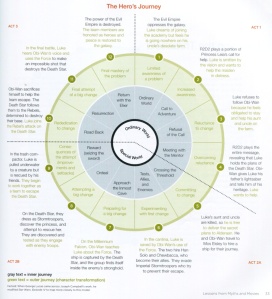Discussion on the Hero’s Journey
Questions
- Why do we like these story arcs like the hero’s journey? (Erynn Ponitus)
- Does the journey that the hero accomplishes always have to be a great big accomplishment/event? Or, can it be a small act that is a great feat to the character/hero? (Sara Haller)
- How do we apply the hero’s journey to our own writing? (Sara Haller)
- Hero’s journey acts as a pattern
- Provides structure and character forms
Quotes
- “In his book, he goes on to describe the cycle of the Journey as incredibly similar to the cycle of life and death. The hero must experience birth, life, death, and rebirth throughout their adventure in various forms. Life and death are not expressly literal, as in the hero themselves are killed or otherwise removed from the realm of the living, but can take on a number of myriad forms. Conflicts, characters, motives, details, and action all have a (re)birth, a life, and a death. And nothing is immune. In my eyes, Campbell effectively argues that the Hero’s Journey is really just what I’ll call the Journey of Life.” (Ben Brzowski)
- “In our modern time, we are able to learn about, study and observe the presence of the monomyth structure but before the term was first coined by Campbell in 1949, for thousands of years the very same story structure was already in effect. What’s truly fascinating is how appealing this structure is to the general audience, regardless of race, gender, ethnicity, and culture. Which leads me to believe that there’s something about this structure, something that lies deep within human nature, within our subconscious, that we can take away from to enrich our own storytelling. The goal is to take something fundamental that you already know works and make it your own, stitch it together with a piece of yourself and make it your own.” (Becky Lin)
- “Not to say that I hate the hero’s journey. I honestly find it quite interesting that so many movies, novels, and other stories can fall into such a recognizable pattern of the ordinary character who rises to greatness, but I find something about it off-putting. I think it’s that I’m disappointed to find that so many of my favorite stories fall into the same storyline (and even more that I never noticed until it was pointed out to me). It also takes away the wonder in some stories for me, since it really seems that the creator is following a well-trodden path. I’m not saying that I don’t enjoy the stories, but that I don’t enjoy seeing the patterns.” (Alexander Lewondski)
- “The monomyth must walk a fine line of finesse to make the traditional new and exciting. In a way, the creation and development of a story parallels the hero’s journey and acts out the various archetypes throughout the creation process. The central elements of the story, theme, plot, characters and conflict, could potentially be viewed as the heroes. The shadow may be writer’s block, time constraints, or negative reviews. The mentors of the story process could be the monomyth pattern, educators, references or life experiences. The herald: an assignment received in the physical, mental or emotional; it may even take the form of a dream. Threshold guardians: the fear of failure, a development budget, time constraints. The shape-shifters archetype may represent a change in the direction of development, a new platform or medium that will be explored. The tricksters of story development may take the shape of faulty technology, like a drained laptop battery when you’re ready to write. And lastly, allies may be supportive family and friends cheering you on to the finish of your own hero’s journey of good story writing.” (Stephanie Hunter)
- “The Hero’s Journey works in fiction but it often doesn’t play out that neatly in documentaries. While many people have interesting stories to tell, they don’t often play out neatly into the Hero’s Journey. Because of this, documentaries often don’t follow the Hero’s Journey cycle. The purpose of a documentary is to shed light on things that we don’t know about. Documentaries often depict an interesting piece of history or an issue that is going on in society. While the Hero’s Journey makes fictional story more compelling and some would argue that is the one of the only ways to create a story that maintains the audience’s attention, documentaries don’t need it to keep the audience engaged. Many documentaries have a compelling story and because of how much the people in the documentary care, the audience is easily brought into the story. The details that are put into a documentary are what keeps an audience’s attention rather than the Hero’s Journey.” (Sheridan Dastrup)
Misc. Discussion
- “Paper feels so permanent, and sloppy, and Computers, on the other hand, feel temporary, and adjustable and private. That is, as long as you’re the only one with the password.” (Amber Sandberg)
- “Before the internet, when a story was created in print or cinema, it remained relatively untouched. If a great story or even a very bad story captures someone’s creativity, it will be transformed into several mediums. Today a story is subject to a huge variety of interpretations and deviations that can be shared and made popular in a matter of hours….” (Amy Garcia)

